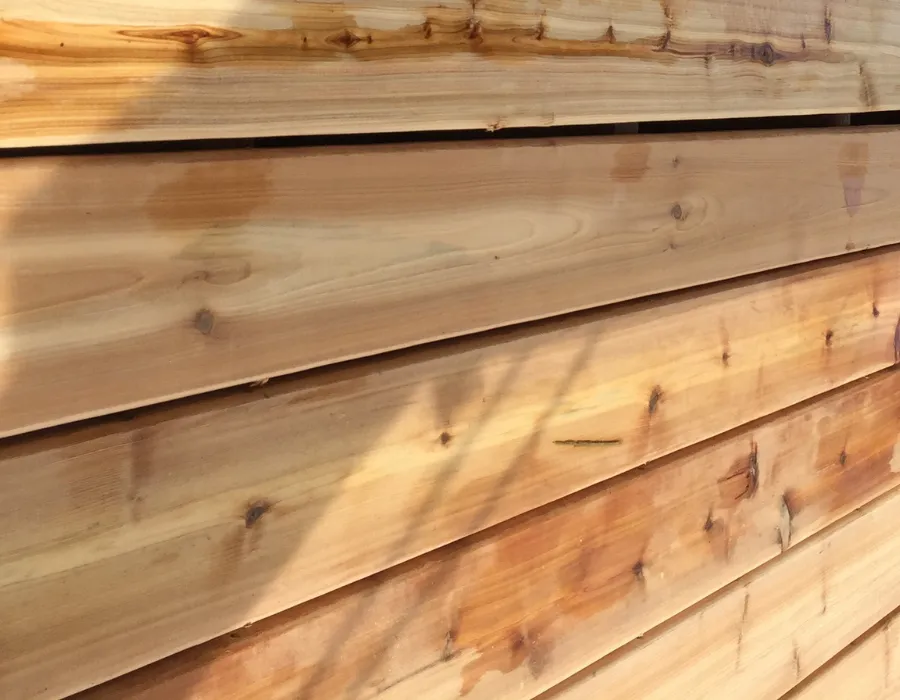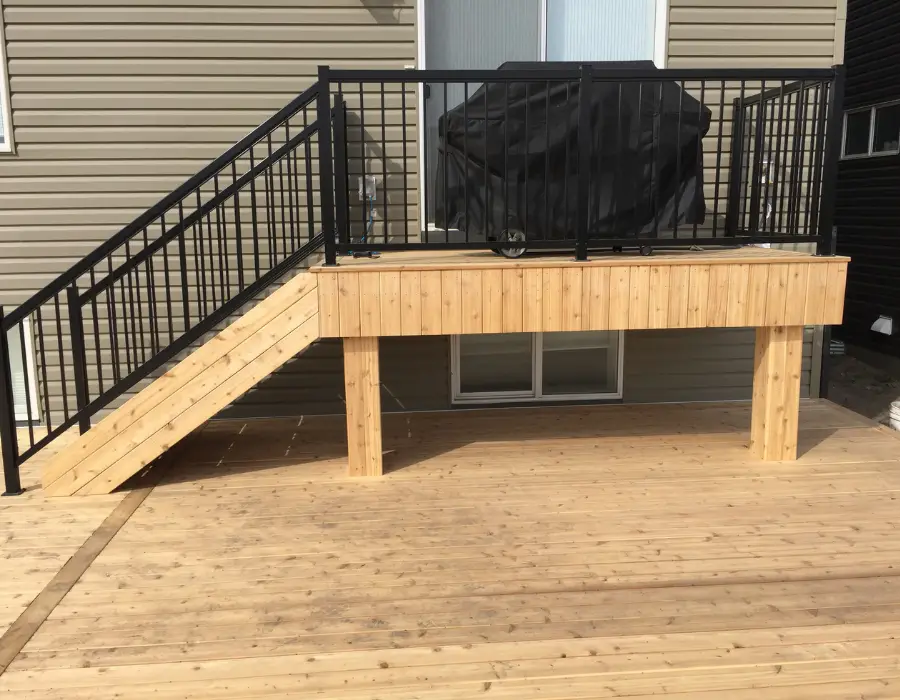Cedar decking is popular, beautiful and readily available in Canada and the United States. With many pros and cons. Reasons to install cedar and not to.
Pros of Western Red Cedar Decking
• Aesthetics
• Versatile
• Naturally resistant to rot
• Stability
• Workability
• Lightweight
• Softer underfoot than pine
• Cooler on bare feet
• Environmentally Friendly
Cons of Western Red Cedar Decking
• Easily scratches
• Requires Maintenance
• Limited decking applications
• Cost
Wow, that’s quite a list of pros with only a few drawbacks
But let’s get to it. What are some reasons for your next deck to be Cedar, and why it shouldn’t be.
Pros of Cedar Decking on your deck
There are many advantages in installing Cedar decking but let’s start at appearance.
Aesthetics, Cedar is a Beautiful
Western Red Cedar, WRC is a beautiful wood with its reddish to pinkish brown random streak along with darker areas. A lovely contrast of dark and light grain colours.
It can be left to “grey,” but a clear seal or stain enhances the decks’ colour and beauty. Ever notice how many deck stains have “cedar” in their name. Cedar is just a beautiful colour.
Speaking of stain, that leads us to the next advantage of cedar decking.
Versatile in Colour When Staining Cedar
Cedar readily accepts and holds a variety of stains. Cedar, a porous wood, drinks up stains, with the stain deeply penetrating, increasing the level of adhesion and bonding. Stain on cedar decking will last longer than on many other kinds of wood.

Lighter cedar decking boards also provide an excellent blank slate for staining. The light wood colour can be stained with a clear coat or a dark red. Cedar decking allows you almost endless stain colour options.
Resistant to Rot, Cedar’s Natural Advantage
Western Red Cedar heartwood has a high level of resins working to protect the tree from rot. Which is still in play as decking. The resins hinder fungus from destroying the wood and your deck, naturally making the wood last longer.
“Rot Resistance: Western Redcedar has been rated as durable to very durable in regard to decay resistance, though it has a mixed resistance to insect attack.”
Just because there is so much debate about it, I must address it. There is some talk about that the newer harvested Cedar is not as resistant to rot as the “old growth” trees harvested years ago. Which has some validity, but it is still more resistant than untreated pine.
How much resistance varies by the age of the tree and part of the tree itself. Heartwood has a higher level of resins than sapwood.
The best solution is to buy quality cedar decking. There are different levels of quality and if you want the best. You need to buy the best. Talk with your supplier, talk details and view the Cedar. It will be worth it.
Cottage Life has a larger article addressing the rot resistance of Cedar .
.
Stability, Cedar Decking Will Warp and Twist Less than Other Wood
Wood naturally absorbs and expels moisture. When it rains on your deck, the boards become wet, but they quickly dry when the sun comes out. The problem is when part of the wood remains wet while the other part rapidly dries. This causes the decking to warp and twist.
Or worse, the core remaining wet and the surface drying. Causing the wood to check, covering your deck with unsightly small “knife” marks covering your deck.

Naturally porous, expanding and contracting with changes in moisture. Cedar decking quickly adjusts to changes in moisture.
Another advantage is the fact cedar shrink less.
Cedar “Shrinkage: Radial: 2.4%, Tangential: 5.0%, Volumetric: 6.8%, T/R Ratio: 2.1”
There are a lot of technical-scientific numbers about cedar, but the short of it is. Cedar is more stable and will shrink less than more popular pine decking.
Workability of Cedar Decking
Cedars have greater stability because of its low density, shrinking less than other popular decking materials. Which also makes it an easier wood to work with. When working with composite decking, much thought must be given to expansion and contraction and the current temperature of the decking. Providing enough room for the decking to expand into in the summer and still the freedom to shrink without looking ugly. One reason mitre joints with composite is such a pain. Cedar remains stable, allowing easier installation.
Lighter than other Wood Decking
Not only does Cedar’s low density make it easier to work with but also to move. Weighing only 23 lbs/ft3 (370 kg/m3), two-thirds the weight of pine.
two-thirds the weight of pine.
Cedar decking weight makes it is easier to work with, being lighter than many other decking options .
.
Softer Underfoot Compared to Pine
Being a softer wood, cedar decking is pleasant underfoot. No, this is not like walking on pillows but still softer on your feet than many other types of decking.
This can be a disadvantage, but we will get to that later.

But if you like to stroll across your deck barefoot, Cedar is a great choice.
Cooler on Bare Feet Than Many Other Decking Materials
What more can I say? On hot summer days, cedar decking will stay cooler than other decking. If you enjoy being barefoot, Cedar will be great decking for you.
This is especially true compared to composite decking. There are some composites that are cooler to the touch , but most are hot in the sun.
, but most are hot in the sun.
Environmentally Friendly
Cedar decking has these three things that make it environmentally friendly.
- Renewable and biodegradable
- Sourced from sustainably managed forests
- Fewer toxins than synthetic decking materials
When looking for environmentally friendly decking options should be considered.
Cons of Western Red Cedar Decking
But western red Cedar has some drawbacks as decking also. It’s not just pros. There are three significant cons with cedar decking.
Cedar Decking Easily Scratches
Here Cedar’s low-density advantage becomes its weakness. With a pebble easily marring the decking surface.
- Cedar 350 lbs(1560 N)
- Spruce Pine 700 lbf (3,110 N)
That’s the pressure required to imbed a .444″ (11.28 mm) diameter steel ball halfway.
Meaning a small rock on the sole of your shoe will easily push into the decking.
Furniture pulled across the deck. Can easily score the deck’s surface.
Even your dog’s claws will reek damage to the cedar.
It just damages too easily.
This is the single biggest reason I hate working with cedar. I have to be so careful how I place my tools. Checking my shoes every time I step on the deck that I don’t accidentally damage it. Its nerve-racking.
Requires Regular Maintenance
Yes, you can let it grey, which has a nice silver to it but.
But you lose the beauty of the Cedar when you let it grey. And even with its natural rot resins, Cedar will last longer when regularly sealed or stained. Cedar decking needs to be softly washed, sanded and stained annually to maintain its integrity and appearance. There is no getting around it. Cedar must be cared for.
I recently was chatting with a past client we had built a cedar deck for a few years ago. They were approaching their fourth staining. And commented that wished they had installed composite decking instead, requiring way less maintenance.
But even with regular maintenance, cedar’s vibrant colours will fade, your deck’s beauty slow fading with the seasons. In twenty years, a cedar deck will not look like the first day you built it.
Limited decking applications
There are two limiting factors for cedar decking, both involving moisture. Those absorbent pores are limiting.
Cedar decking will degrade quicker when close to the ground. Ruling out using Cedar for ground-level decks.
Cedar decking needs sufficient ventilation to maintain its integrity .
.
Not only should you not use Cedar for ground-level decks but also shaded decks. Cedar needs to dry out to maintain its strength and beauty.
If the deck is completely shaded, the water will sit on it, preventing drying. Which can be compound if leaves from the shade tree by the deck lay on the decking. Wet from the rain.
Costly Compared to Treated Decking
Cedar decking is not cheap, nor should it be. Cedar is a quality decking and should not be discounted. But it is more costly than its popular wood competition.
Cedar decking, on average, will cost twice as much as treated decking. A 400 square foot cedar deck will cost an extra $600 or so compared to treated.
Conclusion of Cedar Decking Pros and Cons
Cedar decking is a quality, beautiful, and comfortable decking. There are few decking that compares with the look and feel of a cedar.
But it comes at a price. Cedar will cost more to buy and maintain than pressure-treated decking.
Cedar decking will also need to be treated gentler than other decking. If not, that regular maintenance will cost even more to sand out and repair the decking.
Cedar decking is not for everyone or everywhere. But if you love the look and feel of cedar and are willing to do the work. It makes a great deck to be enjoyed.
